The International Campaign to Ban Landmines – a model for disarmament initiatives?

by Jody Williams
1997 Nobel Peace Prize laureate
3 September 1999
When the International Campaign to Ban Landmines (ICBL) was formally launched in October of 1992, few imagined that the grassroots movement would capture the public imagination and build political pressure to such a degree that, within five years, the international community would come together to negotiate a treaty banning antipersonnel landmines. But the effort, which has been called utopian by most governments and militaries of the world when it was launched by nongovernmental organizations (NGOs), has succeeded. For the first time in history, a conventional weapon in widespread use has been comprehensively prohibited.
The process that brought about the Mine Ban Treaty, has added a new dimension to diplomacy and hope for its wider applicability. When it announced that the International Campaign to Ban Landmines had been awarded the 1997 Nobel Prize for Peace, the Nobel Committee recognized not only the achievement of the ban, but also the promise of the model created with the ban movement. The Committee noted that the Campaign had been able to “express and mediate a broad range of popular commitment in an unprecedented way. With the governments of several small and medium-sized countries taking the issue up…this work has grown into a convincing example of an effective policy for peace.” The Committee concluded: “As a model for similar processes in the future, it could prove of decisive importance to the international effort for disarmament and peace.”
What made the ICBL so successful and a possible model for others?

When wars are over, mines represent a permanent threat to innocent
people for decades. An assortment of mines and unexploded grenades
found in Sarajevo, Bosnia, in 1997.
Copyright © ICBL
Photo: John Rodsted
The changing global situation
One critical element that set the stage for work on conventional weapons was the changing global situation. With the end of the Cold War and shifting centers of power, the world was capable of looking at war and peace in terms other than simply avoiding nuclear holocaust. Organizations and individuals began to look at how wars had actually been fought during the Cold War and what weapons and methods of warfare had had the most significant impact on the lives of civilians. Also, possible responses by governments to issues of global concern were no longer as constrained as during the Cold War, when the two major powers dominated diplomacy.
It was NGOs in the late 1980s and early 1990s that began to seriously think about trying to deal with the root of what was beginning to be recognized as a global humanitarian crisis – the tens of millions of landmines contaminating dozens of countries around the world. The work of NGOs across the board was affected by the landmines in the developing world. Human rights organizations, children’s groups, development organizations, refugee organizations, medical and humanitarian relief groups–all had to make huge adjustments in their programs to try to deal with the landmine crisis and its impact on the people they were trying to help. It became very clear that to eliminate the problem, it would be necessary to eliminate the weapon – landmines would have to be banned.
The NGO community did not wait for anyone to appoint them leaders on the issue – they saw that a critical problem had to be addressed and they took it up. These organizations were the experts on the multiple issues related to landmines and they worked diligently to produce the facts and information, based on their work in the field, to establish that expertise and provide the grounds for their demand for a global ban on the weapon. With the realization that coordinated political action would be necessary to take landmines out of the world’s arsenals, a handful of these NGOs began to come together, in late 1991 and early 1992, in an organized effort to ban antipersonnel landmines. From this inauspicious beginning, the International Campaign has become an unprecedented coalition of over 1,200 organizations working together in 80 countries, to achieve the common goal of a ban on antipersonnel landmines.
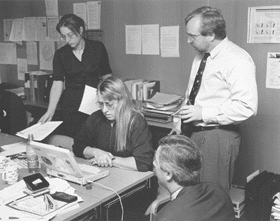 |
| Little bureaucracy, no nonsense. ICBL’s Jody Williams, Steve Goose and Mary Wareham working on responses to the draft of the Mine Ban Treaty during a conference in Oslo in September 1997. Copyright © ICBL Photo: John Rodsted |
A non-bureaucratic campaign
A core strength of the Campaign, which still seems ill-understood by many, has always been its loose structure. The ICBL is a true coalition made up of independent NGOs. There has been no secretariat. No central office. The NGOs that make up the ICBL have been joined together through their common goal of banning landmines, but there has never been an overarching, bureaucratic Campaign structure that could dictate to the members how they should best strive to contribute to the goal – or that member organizations could expect to do the critical work of the campaign for them. The ICBL was deliberate in not establishing a central office; each NGO had to find a way to participate in making the campaign work. This structure helped to insure that the ICBL ‘belongs’ to all of its members and that these members would have to be active in the process to achieve the Campaign’s goals.
Members of the ICBL have always met regularly to develop overall strategies and plan joint actions but beyond that, each NGO and each National Campaign has been free to carry out whichever aspects of the work best fit its individual mandate, political culture and circumstances. ICBL meetings have never been a coming together of ‘talking heads’ – each meeting has resulted in concrete plans of action. And these plans of action were made up of steps that have been believed to be achievable and that would help build and maintain a sense of forward motion and accomplishment in the ban movement.
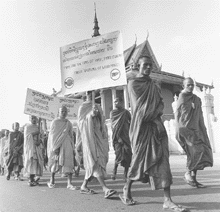
A global campaign. Monks march in Phnom Penh, Cambodia, in April 1996.
Copyright © ICBL
Photo: John Rodsted
The overall strategy of the International Campaign has always been to press for national, regional and international measures to ban landmines – and in the post-Treaty period, to insure its universalization, implementation and Treaty compliance. Because the Campaign is a loose coalition, spread all over the world and working at a number of levels, clear and consistent communication has been critical to its success. Individual members of the Campaign gained strength by being able to speak with authority about what was happening everywhere to eliminate the problem. Sharing the successes and failures of the work, empowered all organizations and lessened the possibility of isolation of any one. Because the communication has been so strong and so consistent, the ICBL often has known of developments related to the ban movement before governments, which made it a focal point of information for governments and NGOs alike. This also helped build confidence between governments and the ICBL.
Mail-fax-electronic mail
But there has grown something of a mythology that what has made the ICBL so unique has been its reliance on electronic mail. Certainly the ease and speed of communication as a result of technological developments have had a great impact on the ability of civil society from diverse cultures to dialogue and formulate global political strategies, but e-mail alone has not “moved the movement.” When the ICBL was not much more than a handful of disparate NGOs, it was clear to the initiators of the Campaign that in order to hold together NGOs of such diverse interest, these organizations would have to feel an immediate and important part of developing the work of the Campaign.
In the early years of the ICBL, this was achieved by extensive use of the fax, and regular mailings to campaign members of documents and informational updates. The fax machine was relatively new, it was “exciting”. Information arriving almost instantaneously by fax was perceived to be more important – and thus more deserving of immediate response – than regular mail. Thus, it was fax and telephone communication upon which the ICBL relied for much of its almost daily communications. Even though this was a relatively large expense, in the early years the bulk of NGOs work to ban mines were located in the North, where these costs were not as prohibitive as in the South. It was not until the ICBL was able to broaden its work from largely mine-producing countries to mine-affected countries that its members began to make the shift to electronic communication – a switch that was not fully achieved until well into 1996. Electronic mail has permitted the ICBL to carry out its priority of frequent and timely internal communication to a greater degree than ever before.
Personal relationships
As important – and many might contend more so – as fax, phone and e-mail to link together the huge coalition, has been networking through travel and the building of personal relationships, both within the Campaign and between campaigners, and the various government and military representatives. Indeed, e-mail has been used relatively little for communications outside of the campaign, and the much remarked upon close cooperation between governments and NGOs during the Ottawa Process was more the result of face-to-face meetings than anything else.
It was the combination of all the above elements that really resulted in the partnership between the ICBL and governments that brought about the Mine Ban Treaty and continues to this day in order to universalize the Treaty and insure its full implementation. The field-based experience of the NGOs provided the basis for its expertise and was the underpinning of its credibility as the engine of the mine ban movement. Its clear and consistent message and concrete action plans which met with continued success helped build the political will that allowed governments and NGOs to take the critical steps toward a ban.
The role of governments
Confidence between the ICBL and governments grew so that as momentum for a ban continued to develop, when the Campaign called upon individual governments to come together in a self-identifying pro-ban bloc, they did. There is, after all, strength in numbers. So a series of meetings between pro-ban governments and the ICBL were held in Geneva in the spring of 1996. Historically NGOs and governments have too often seen each other as adversaries, not colleagues, and these first meetings felt very tentative, and some in the NGO community worried that governments were going to ‘hijack’ the process in order to undermine a ban. But by the third meeting, at the May 3, 1996 conclusion of the Review Conference of the one failed treaty that attempted to control landmine use, the Canadian government offered to host a governmental meeting in October of that year, in which pro-ban governments would come together and strategize about how to bring about a ban – and they worked on an almost
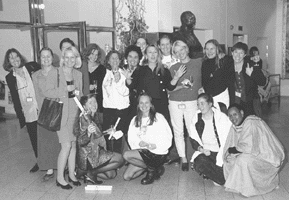 |
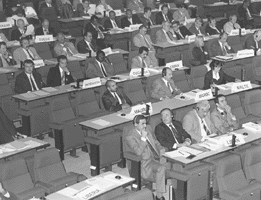 |
| A large majority of those who were campaigning against land mines were women. After some time government representatives, mostly men, more or less enthusiastically engaged in the process of framing an international treaty. Top: Some of the women members of the ICBL celebrating in Oslo in September 1997. Bottom: From a conference in Brussels in June 1997. Copyright © ICBL Photo: John Rodsted |
The results of that now-famous meeting are historic. Out of the Ottawa meeting, came the Canadian challenge, issued by its Foreign Minister Lloyd Axworthy, to negotiate a simple, unambiguous ban treaty within one year. This challenge gave birth to what is now known as the Ottawa Process, culminating in the signing of the Mine Ban Treaty in Canada in December of 1997. While even the truly pro-ban states at the October 1996 Ottawa meeting were horrified by the challenge, it was precisely Canada’s willingness to step outside of “normal” diplomatic process which was another key element in the success of the ban movement.
Governments had said they were pro-ban. They had come to Ottawa to develop a road map to create a ban treaty and had signed a Declaration of intent. The challenge had put them between a rock and a hard place and they had to respond. And once they recovered from that initial shock, the governments that really wanted to see a ban treaty as soon as possible, rose to the challenge and negotiated the treaty in record time. But without the public awareness and political will created by the ICBL, this step could never have happened – just as without truly committed governments, willing to negotiate a ban, the treaty would have remained a utopian dream.
The Oslo negotiations of September 1997 were unique for a number of reasons. As noted above, for the first time, smaller and middle-sized powers had come together, to work in close cooperation with the nongovernmental organizations of the International Campaign to Ban Landmines, to negotiate a treaty which would remove from the world’s arsenals a weapon in widespread use. For the first time, smaller and middle-sized powers had not yielded ground to intense pressure from a superpower to weaken a treaty to accommodate the policies of that one country. Perhaps for the first time, negotiations ended with a treaty stronger than the draft on which the negotiations were based! The treaty had not been held hostage to rule by consensus, which would have inevitably resulted in a gutted treaty. And throughout it all, NGO were in the negotiations; their mere presence helped insure that the will of civil society for a true ban would have less chance of being thwarted by compromise.
Binding international law
As the world knows, in December of 1997, 121 governments came to Ottawa to sign the Mine Ban Treaty. And the numbers continue to grow – and the momentum remains unrelenting. At the time of this writing, 135 governments have signed the Treaty and 81 have ratified it. The Mine Ban Treaty became binding international law on March 1, 1999 and just two months later, well over one hundred countries came together in Mozambique to assess progress on the Treaty.
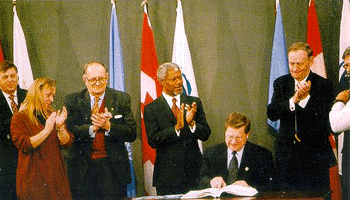
Jody Williams, ICBL Coordinator, Cornelio Sommaruga, President of the International Committee of the Red Cross, U.N. Secretary-General Kofi Annan and Canadian Prime Minister Jean Chrétien watch Canada’s Foreign Minister Lloyd Axworthy sign the Mine Ban Treaty in December 1997.
Copyright © Department of Foreign Affairs and International Trade Canada
Photo: Knudsens Fotosenter
The ICBL, and its partnership with governments, has resulted in a truly remarkable process. Landmines have been used since the U.S. Civil War and the Crimean War, yet through concerted political action, they will be taken out of the arsenals of the world. This process has clearly demonstrated that civil society and governments do not have to see each other as adversaries. It has shown that in a partnership of civil society and governments, each brings particular assets to the process, which is made stronger by the participation of both. It demonstrates that small and middle powers can work together with civil society and address humanitarian concerns with breathtaking speed. It shows that such a partnership can be a new kind of “superpower” in the post-Cold War world.
Nobel Prizes and laureates
Six prizes were awarded for achievements that have conferred the greatest benefit to humankind. The 14 laureates' work and discoveries range from quantum tunnelling to promoting democratic rights.
See them all presented here.
